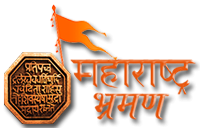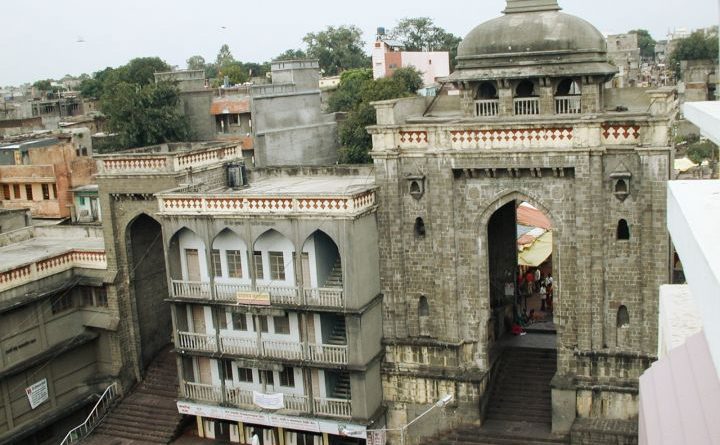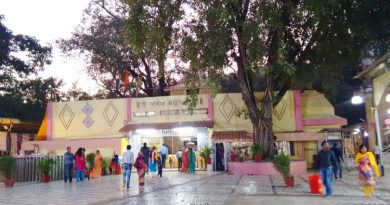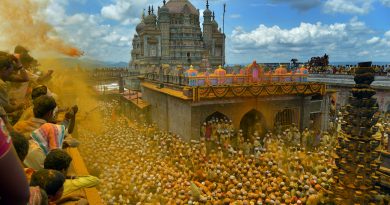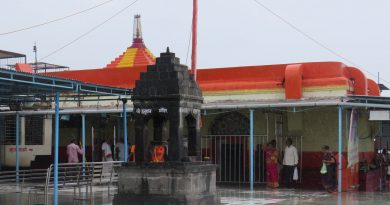Tulja Bhavani Temple
Tulja Bhavani Temple is a Hindu temple of Goddess Bhavani…
Tulja Bhavani Temple is a Hindu temple of Goddess Bhavani. It is located in Tuljapur in Osmanabad district of Maharashtra and is considered as one of the 51 Shakti Pithas. It is situated 45 km from Solapur. The temple was built in c. 12th century CE. Another Tulja Bhavani temple was built during 1537-1540 CE in Chittorgarh. Another temple of Tulja Bhavani is in village Patnakuva Gandhinagar, Gujarat. Tulja Aai is called swayambhu Tulja bhavani.It is said that the Goddess came here from Tuljapur here in the 14th century.
The second among the ‘Shaktipeeths’ is Tulja Bhavani of Tuljapur. It is the family deity of the Bhosale Royal family. the founder of the Maratha kingdom, Shivaji Maharaj always visited the temple to seek her blessings. It is believed that the Goddess gifted him a sword – ‘the Bhawani sword’ – for success in his expeditions. The history of the temple has been mentioned in the ‘ Skanda_Purana ‘. There was a sage known as “Kardam” After his death his wife “Anubuti” had performed a penance at the banks of river “mandakini ” for Bhavani mata to look after her infant child. While performing the penance the demon known “Kukur” tried to disturb her penance during which Mata Bhavani came to the aid of “Anubuti” and killed the demon “Kukur”. From that day onwards the Goddess Bhavani came to be known as Tulja Bhavani. The temple is located on the hill of “Bala ghat”.
Tulja Bhavani Idol:
The idol of Goddess Tulja Bhawani is a `swayambhu` (self-orinted). Bhavani is worshipped in the form of a three-foot high granite image, with eight arms holding weapons, bearing the head of the slain demon Mahishasura. Bhawani is also known as Tulaja, Turaja, Tvarita and Amba. The main entrance goes by the name of `Sardar Nimbalkar Pravesh Dwar`. There are two main entrances to get to the main temple. One is called the Raja Shahaji Mahadwar, and the other as Rajmata Jijavu main gate. Going through the Sardar Nimbalkar Pravesh Dwar, there is the Markandeya Rishi`s Temple in the right. After getting down through the stairs, comes the main Tulija Temple. The `yagna kund` is in front of this temple. In the floor of the two main gates (Raja Shahaji Mahadwar and Rajmata Jijavu main gate), there are two libraries named, Shree Santh Dnyaneshwar Dharmik Library and Shree Tukaram Dharmik Library. After alighting from the stairs, there is `Gomukh Theerth` on the right side and `Kalakh`, also known as `Kallol Theerth` on the left side. Before the darshan of the Goddess, devotees take a dip here in these theerths. There are also Amruth Kund and Duth temple in the premises. A Siddhi Vinayak temple adorns the left side of the main gate, to the right being the Aadishakti, Aadimata Matangadevi temple respectively. A temple of goddess Annapurna temple is also present in the premises.Legendary stories naturally surround the temple. A demon, Matanga was wrecking havoc upon the gods and humans. Unable to find any solution, they turned to Lord Brahma for help, and upon His advice turned to Goddess Shakti, who took up the form of a destroyer and powered by the other (Sapta) Maataa Varaahi, Brahmi, Vaishnavi, Kaumaari Indraani and Saambhavi, vanquished the demon Matanga and rendered a peace regime. Legend also states that Bhawani finished another demon that had taken up the disguise of a buffalo (Mahisha), and took shelter on the Yamunachala Hill, which is now home to the Tuljabhawani temple.
Daily puja rituals:
Chaughada (holy drumming ritual at morning): At 5 a.m., the morning before the Puja starts, the large drums in the drum house (Nagarkhana) of Tuljabhavani temple are played loudly. The meaning of this drumming is that the devotees should be prepared and come before the puja. The drums are drummed (Chaughada) three times during the day.
Charantirtha (sacred water ritual of goddess feet and mouth): The puja performed at 5:30 a.m. This puja is performed by the hands of Mahant Vakoji Bua. At the time of Charantirtha puja, the representative of Karvir (Kolhapur) princely state is present. The Mahanta washes the goddess’ mouth and feet with hot water, odoriferous oil, dudhkhir (milk), pan. Devotees sing the Arti (holy songs). After this Bhaji-Bhakri the Nevaidya (holy meal) is offered to the goddess. The descendant representative of the devotee Uparkar offers this Nevaidya. Later the Nevaidya of Kheer by the representative of Karvir (Kolhapur) princely state is offered.
Abhishek (holy bath ritual to goddess) Puja (prayer): At 9 o’clock in the morning the goddess has a bath of Panchamrut and curd. Honey, banana and sugar is rubbed to the goddess’ mouth. The Gomukh (holy pond of the goddess) water is used for the goddess’ bath. During this puja some people bathe the holy throne of goddess by curd, mango liquid, shreekhand. After the bath, Mahanevaidya (big holy meal) by the Karvir (Kolhapur) princely state is offered to goddess.
Dhup arti: At noon, the clergy and devotees praise the goddess by singing holy songs and lighting the dhup and karpur (camphor).
Abhishek (holy bath ritual to goddess): At 6 o’clock that evening, the goddess is bathed by Panchamruta and water from Gomukha and puja is performed. The arrangement of these materials is done by the Karvir (Kolhapur) princely state.
Shejarti (nightly sleep songs ritual) and Prakkshal: At night the Prakkshal ritual is performed using the holy water from the Gomukha and the Nevaidya of Tup (Indian liquid butter) and Bhat (cooked rice) is offered.
During every Aarti ritual musical instruments such as tal, dimdi and zanj are played. Gondhali plays the Sambal instrument as Chaughada are drummed.
How to reach:
Roadways:
Pilgrims coming from Southern parts can reach this place by roadways through Naladurga. Pilgrims from northern and eastern regions can reach Tuljapur through Solapur while those coming from eastern regions can take a highway through Nagpur or Latur.
State owned and private bus services are available from the neighbouring states, with the journey breaking at places mentioned above. Pilgrims can also travel to this place by their own vehicles.
Railways:
Solapur station, located 45 km away, is the nearest railway station to Tuljapur. Pilgrims can reach here through road from the station.
Airways:
The nearest airports to Tuljapur are Pune and Hyderabad. Pilgrims can reach here from these airports through roadways.
